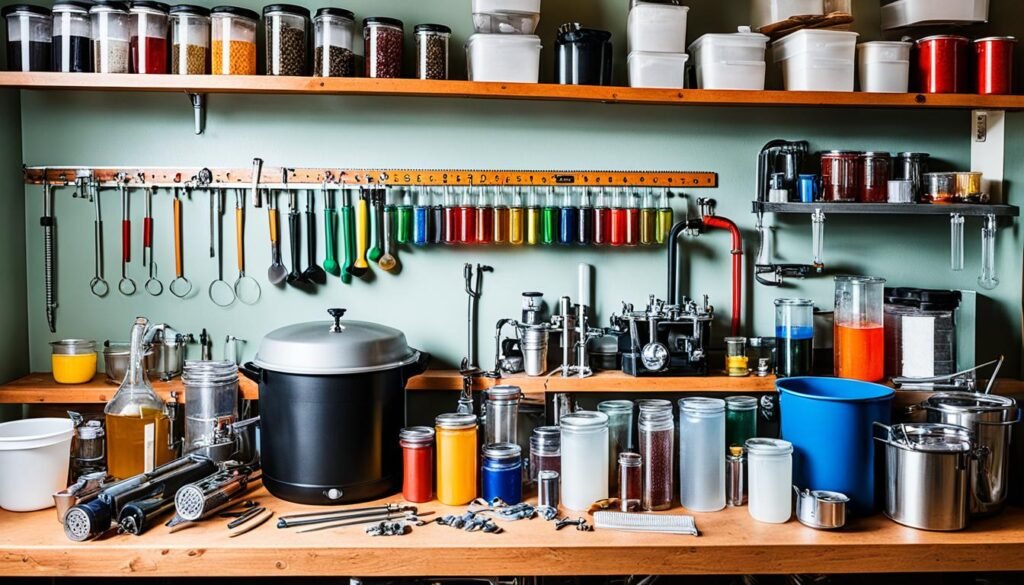Aspiring home brewers in South Africa, get ready to discover the joys and cost-saving perks of DIY beer making. Brewing beer from the comfort of your home has never been more accessible. With budget-friendly beer brewing techniques, you don’t need a fortune or a degree in zymurgy to enjoy your own batch of delicious, personalized homemade beer recipes. Even with minimal equipment and a straightforward process, you can dive into home brewing and create something that’s not only easy on the palate but also on the pocketbook. Join us as we guide you through affordable homebrewing tips that will set you up for success in the flourishing South African DIY brew scene.
Key Takeaways
- Understanding the foundational steps of home brewing in South Africa.
- Tips for sourcing cost-effective brewing equipment and ingredients.
- Basic yet solid homemade beer recipes suitable for beginners.
- Financial benefits of DIY beer making without compromising on taste.
- Techniques to ensure your budget-friendly beer brewing journey is a success.
- Valuable affordable homebrewing tips to optimize your brewing process.
The Basics of Brewing on a Tight Budget
Embarking on the journey of creating your very own do-it-yourself brewery need not strain your wallet. In fact, right here in South Africa, the pursuit of brewing palatable and high-quality beer at home has become an accessible venture for many. The secret is a return to the bare essentials; a method that highlights the simplicity of how to make cheap homemade beer without compromising on taste or satisfaction.
Understanding the bare-bones approach to homebrewing
The transformation of humble ingredients into an aromatic brew is a process steeped in history. The essential craft of homebrewing hinges on the fermentation magic performed by yeast, which feasts on sugars to produce alcohol. By adopting a minimalist strategy, any beer enthusiast in South Africa can embark on a cost-effective do-it-yourself brewery adventure with just a few basic ingredients and equipment. The goal is to demystify the process and make it inclusive for all aspiring brewers.
Why making good beer doesn’t have to be complicated or expensive
Contrary to popular belief, a heavyweight wallet is not required to produce a desirable homemade brew. By focusing on traditional, straightforward brewing methods, one can learn how to make cheap homemade beer that rivals the complexity and flavor of commercially available ones. In South Africa, where craft beers have surged in popularity, the home brewing movement champions economical, yet effective approaches, proving that a rewarding brewery experience can be achieved with a frugal mindset.
The Essential Supplies You’ll Need

Pursuing the path of budget-friendly beer brewing doesn’t require a fortune to start. Careful selection of home brewing equipment and ingredients can lead to the creation of delightful homemade beers without depleting your wallet. Below we’ll discuss how to find affordable equipment and choose the right ingredients that keep your brewing both cost-effective and enjoyable.
Finding affordable brewing equipment
Aspiring brewers should first focus on acquiring the essential tools of the trade. Often, the hunt for home brewing equipment doesn’t take you further than the nearest thrift store or yard sale. The primary necessity, a large kettle, can often be found second-hand. A clean, food-grade bucket for fermentation is another must-have that can be sourced economically. These items, along with some creativity and ingenuity, can set you up for a successful brewing experience on a budget.
Choosing the right ingredients for budget-friendly beer
Casting the spotlight on ingredients, there are cost-efficient yet tasty options available. Tap water, for most, is a suitable choice, saving the expense of special brewing water. Malt extract is customarily selected based on flavor preferences and can vary in price. Opting for more affordable hops like Cascade can significantly lower costs without compromising taste. Likewise, packets of dry yeast are economical and can yield delightful results for those new to homebrewing.
| Equipment/Ingredient | Cost-Saving Tips | Recommended Source |
|---|---|---|
| Large Brewing Kettle | Check thrift stores, garage sales, or online marketplaces for second-hand options. | Thrift Stores/Yard Sales |
| Food Grade Bucket | Purchase a new inexpensive bucket or repurpose one, ensuring it’s cleaned and sanitized. | Home Improvement Stores |
| Malt Extract | Buy in bulk if possible and choose base malts for the most savings. | Local Homebrew Shop |
| Hops | Cascade hops are versatile and often priced lower than other varieties; buy in bulk when sales occur. | Online Retailers |
| Dry Yeast | Buy multi-packs or look for discounts on near expiration packets, which can still be viable. | Local Homebrew Shop |
With a minimalist approach to both equipment and ingredients, you can simplify the brewing process, making it manageable for those new to the craft and save money—achieving affordable homebrewing without sacrificing quality or enjoyment.
Step-by-Step Brewing Process for Beginners

Embarking on DIY beer making could seem daunting for novices, but with the right guidance and a passion for craft, producing delicious homemade beer recipes is genuinely achievable. Below is an easy-to-follow blueprint to help you learn how to make cheap homemade beer from the comfort of your home.
Preparing Your Brew: Sanitization and Water Selection
Maintaining a sterile environment is paramount. Begin by sterilizing your brewing equipment with a chlorine bleach solution to prevent any unwanted bacteria from spoiling your batch, a common beginner’s oversight. Proper water selection is next—tap water is adequate, but ensure that it’s void of any off-flavors which might affect your finished product.
The Art of Combining Malt, Hops, and Yeast
The essence of beer lies in its ingredients—the malt, the hops, and the yeast each play a pivotal role. Start by heating your water and mixing in the malt extract obtained from your beer-making kit. This mixture, also known as the ‘wort’, is the basis for your beer. Next, introduce the hops, balancing bitterness and enhancing flavor according to the recipe you have chosen. Oxygenate the cooled wort to ensure a healthy environment for the yeast, which will be responsible for fermentation.
Adding the yeast need not be a complex process. Some recipes suggest rehydrating the dry yeast, while others allow for direct addition to the wort. This flexibility is one of the joys of DIY beer making. Carefully pour the wort into your sanitized fermenter, add the yeast, and seal it up. The yeast will now begin its work, converting sugars into alcohol and carbon dioxide, effectively creating your homemade brew.
Achieve your desire to make cheap homemade beer by mastering these basic steps, and you’ll be able to enjoy the fruits of your labor in a few weeks. Remember, patience and attention to detail during the brewing process can lead to impressive results even on a budget. Start this rewarding journey into the world of home-crafted beer and take pride as you share and enjoy your very own homemade creations.
Mastering the Fermentation Without Breaking the Bank
Embarking on the do-it-yourself brewery journey isn’t just about mixing malt, hops, and yeast; it’s about fostering a transformation. The magic of turning sweet wort into the golden ambrosia known as beer lies within the realm of fermentation—a phase where frugality meets proficiency. It’s here, in the delicate balance of yeast metabolism, that the principles of budget-friendly beer brewing find their stronghold. In South Africa, where artisanal skills and cost-saving measures are equally celebrated, mastering fermentation is a testament to both the brewer’s craft and cunning.
The importance of yeast management for cost efficiency
Yeasts are the unsung heroes of homebrewing; they are voracious entities that consume sugars to create alcohol and carbonation. For those seeking affordable homebrewing tips, knowledge of yeast management is invaluable as it offers the possibility of reuse, cutting down on recurring expenses. By harvesting and storing viable yeast strains from a batch, not only does one become environmentally conscious, but also economical. Careful attention to maintaining sterile conditions when transferring the yeast to future batches ensures consistency and quality in every homemade draft.
DIY fermentation tips and airlock solutions
When it comes to fermentation, maintaining an ideal temperature and preventing contamination are crucial. A homemade airlock, ingeniously crafted from plastic wrap and tape, allows carbon dioxide to safely escape while safeguarding the brew from external pollutants. This sense of ingenuity is at the heart of budget-friendly beer brewing, avoiding the unnecessary expense of commercial airlocks without compromising effectiveness. Patience, an invaluable resource, is required as the wort undergoes its silent symphony for up to two weeks. It’s the adherence to this time-honored process, patiently waiting for nature’s course, that yields a brewer’s true reward—a flavorful, self-made beer that satisfies the soul without draining the wallet.
FAQ
What are the basic steps for brewing beer at home?
Home brewing involves boiling water and malt to create a wort, cooling the wort, adding yeast for fermentation, and bottling the finished beer after fermentation is complete. Each step requires careful attention to sanitation and patience as the beer develops.
Can I make good beer without expensive equipment?
Absolutely! You can make satisfying beer at home using basic equipment like a large kettle, a food-grade bucket for fermenting, and household items for sanitization and bottling. You don’t need high-end gear to start your DIY brewery adventure.
Where can I find affordable brewing equipment?
You can often find brewing equipment at thrift stores, yard sales, or online marketplaces. Some home brewers also repurpose large pots and other kitchen items to save on costs. Joining home brewing forums or groups may also lead to finding second-hand equipment.
How can I select the right ingredients on a budget?
Quality homemade beer can be brewed using basic ingredients such as malt extract, affordable hop varieties like Cascade, and dry yeast. Choose ingredients based on your taste preferences and the style of beer you want to make.
What is the importance of sanitization in brewing?
Sanitization is crucial to prevent contamination and ensure your beer turns out great. Clean all equipment with a chlorine bleach solution or other recommended sanitizers to kill off any unwanted bacteria before you begin brewing.
How do I create a homemade airlock for fermenting beer?
You can create a simple airlock with plastic wrap and tape to allow carbon dioxide to escape from the fermenter without letting in contaminants. This improvised solution can replace commercial airlocks and help keep your brewing process budget-friendly.
What’s the role of yeast in beer brewing, and how can I manage it effectively?
Yeast is essential for fermentation, turning sugars into alcohol and carbon dioxide. Reusing yeast from previous batches can be cost-effective. Ensure you maintain a proper, consistent temperature during fermentation to keep the yeast active and healthy.
Is it necessary to have a thermometer or can I manage without one?
While a thermometer can provide precision, it’s entirely possible to brew beer without one, especially when just getting started. You can judge temperatures by feel, looking for a “warm but not hot” range, though this may result in less consistency between batches.
How long does the fermentation process take?
Typically, primary fermentation can take anywhere from 1 to 2 weeks. It’s important to be patient and not rush this process, as it allows the flavors to develop and the alcohol content to reach the desired level.
Can I use tap water for brewing?
Yes, you can use tap water for brewing, though the quality and taste can vary by location. If your tap water tastes good to you, it’s likely fine for brewing. Alternatively, you can use bottled or filtered water for more consistent results.
